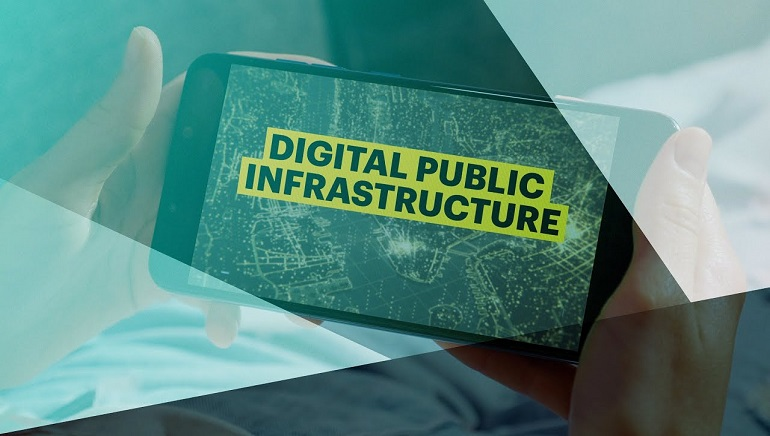Description

Copyright infringement not intended
Picture Courtesy: asiaone.co.in
Context: India's approach to Digital Public Infrastructure (DPI) is a remarkable story of technological innovation and inclusive development.
Digital Public Infrastructure (DPI)
About
- Digital Public Infrastructure (DPI) is a term that has gained prominence in recent years as governments and organizations worldwide increasingly recognize the importance of digitalization in delivering public services.
- DPI serves as the backbone for the deployment of essential digital services to citizens and users, aiming to bridge the gap between technology and the public.
Features of DPI
Accessibility
- Inclusive Design: DPI is designed with inclusivity in mind, ensuring that digital services are accessible to a wide range of users. This includes considering various user needs, such as those in remote or rural areas, individuals with disabilities, and users with limited digital literacy.
- User-Friendly Interfaces: DPI platforms often feature user-friendly interfaces with clear navigation and design principles that accommodate users with different levels of technological expertise.
- Localization: DPI may offer services in multiple languages and dialects to cater to diverse linguistic communities, making digital services more accessible to non-English-speaking populations.
Security
- Encryption: DPI employs advanced encryption techniques to protect user data during transmission and storage. This encryption ensures that sensitive information remains confidential and secure from unauthorized access.
- Authentication: Multi-factor authentication and robust identity verification mechanisms are implemented to ensure that users are who they claim to be, enhancing the security of digital interactions.
- Regular Audits: DPI undergoes regular security audits and vulnerability assessments to identify and mitigate potential weaknesses, reducing the risk of data breaches or cyberattacks.
- Compliance: DPI systems often adhere to strict data protection and privacy regulations, ensuring that they comply with legal requirements to safeguard user information.
Interoperability
- Standardized Protocols: DPI relies on standardized communication protocols and data formats to ensure compatibility with various digital platforms and services.
- APIs (Application Programming Interfaces): APIs are often provided to facilitate integration with third-party services, enabling a seamless flow of data between systems.
- Data Exchange: Interoperability allows data exchange between different government agencies and departments, streamlining administrative processes and improving data sharing for better decision-making.
Scalability
- Elastic Infrastructure: DPI infrastructure is designed to be elastic, meaning it can expand or contract in response to changing demands. This scalability ensures that the system remains responsive during spikes in user activity or as technology evolves.
- Cloud-Based Solutions: Many DPI components leverage cloud computing, which offers scalability by allowing resources to be dynamically allocated based on current requirements.
Reliability
- Redundancy: DPI often incorporates redundancy in critical components to minimize the risk of system failures. Redundant servers, data centres, and network connections help ensure uninterrupted service availability.
- Disaster Recovery: Robust disaster recovery plans are in place to mitigate the impact of unforeseen events, such as natural disasters or cyberattacks, to maintain service reliability.
- Service-Level Agreements (SLAs): DPI providers typically establish SLAs that outline service uptime guarantees, giving users’ confidence in the reliability of the infrastructure.

Significance of DPI
Inclusive Growth
- Digital Divide Reduction: DPI plays a pivotal role in reducing the digital divide by ensuring that digital services are accessible to all citizens, irrespective of their geographical location or socioeconomic background. This inclusivity empowers marginalized communities and promotes social equity.
- Equal Access to Opportunities: By providing access to essential services like healthcare, education, and financial services, DPI helps individuals in remote areas and underserved populations access opportunities that were previously out of reach.
- Enhanced Social Inclusion: DPI facilitates social inclusion by connecting individuals with disabilities to assistive technologies and services tailored to their specific needs, fostering a more inclusive society.
Efficient Governance
- Streamlined Administrative Processes: DPI optimizes government operations by digitizing administrative processes, reducing paperwork, and minimizing bureaucratic hurdles. This streamlining enhances the efficiency of public administration.
- Improved Service Delivery: Citizens benefit from improved service delivery as DPI allows government agencies to offer services more rapidly, accurately, and transparently. This leads to enhanced citizen satisfaction and trust in government institutions.
- Cost Savings: By automating routine tasks and reducing the need for physical infrastructure, DPI can lead to significant cost savings for governments, allowing them to allocate resources more effectively.
Economic Development
- Digital Entrepreneurship: DPI creates an environment conducive to digital entrepreneurship and innovation. It enables startups and small businesses to access digital platforms, reach a broader customer base, and compete in the digital marketplace.
- Job Creation: The growth of digital businesses and startups supported by DPI can lead to job creation and economic diversification. It fosters a vibrant digital ecosystem that contributes to economic resilience.
- Digital Skills Development: DPI initiatives often include programs for digital skills development and training, equipping individuals with the competencies needed to participate in the digital economy.
Data-driven Decision Making
- Evidence-based Policymaking: DPI generates vast amounts of data from user interactions and service delivery. Governments can leverage this data to inform evidence-based policymaking, monitor the impact of policies, and make informed decisions that benefit society.
- Efficiency Optimization: Data analytics within DPI can identify areas where government operations can be made more efficient and cost-effective, leading to better resource allocation and governance.
- Predictive Insights: DPI allows governments to anticipate trends and respond proactively to emerging challenges, whether in public health, infrastructure development, or social services.
Steps taken by India
Aadhaar
- Unique Digital Identity: The Aadhaar program assigns a 12-digit unique identification number to every Indian resident, linked to their biometric and demographic information. This digital identity serves as a secure and standardized way to verify identity.
- Access to Services: Aadhaar has been integrated into various government services, including welfare programs, subsidies, and financial services. It enables residents to access these services efficiently and securely.
- Biometric Authentication: Aadhaar uses biometric authentication methods like fingerprint and iris scans, enhancing security while ensuring the uniqueness of identities.
Unified Payments Interface (UPI)
- Digital Payments Revolution: UPI has transformed the way financial transactions are conducted in India. It allows individuals to make instant, secure, and cashless payments using mobile phones or computers.
- Financial Inclusion: UPI has played a significant role in promoting financial inclusion by providing a user-friendly platform for banking services, even in remote and underserved areas.
- Third-party Apps: UPI enables third-party app developers to create innovative payment solutions, fostering competition and innovation in the fintech sector.
Digital Locker (DigiLocker)
- Secure Document Storage: DigiLocker provides citizens with a secure cloud-based platform to store and share digital copies of documents such as academic certificates, government-issued IDs, and vehicle registration papers.
- Reduced Paperwork: By eliminating the need for physical documents, DigiLocker reduces paperwork and bureaucracy in various government and private sector interactions.
- Interoperability: DigiLocker is designed to be interoperable with other government systems, making it easier for users to share documents with government agencies and educational institutions.
e-Governance Initiatives
- Digital India: The Digital India program aims to transform India into a digitally empowered society and knowledge economy. It encompasses a wide range of initiatives, including the digitization of government records, broadband connectivity expansion, and digital literacy programs.
- e-Gov Services: Various government services, such as obtaining certificates, licenses, and land records, are now available online through e-Governance portals. This reduces the need for physical visits to government offices and simplifies service delivery.
- Online Portals: Government websites and portals have been created to provide citizens with access to information, services, and resources, improving transparency and public engagement.
Challenges
Digital Divide
- Unequal Access: Despite the progress made, a significant portion of the population in many countries, including India, still lacks access to reliable internet connectivity and digital devices. This digital divide can exacerbate existing socio-economic disparities.
- Rural and Remote Areas: In particular, rural and remote areas often face challenges in terms of internet infrastructure and affordability, making it difficult for residents to benefit from DPI services.
- Digital Literacy: Even when access is available, disparities in digital literacy levels can hinder the effective use of DPI services, especially among elderly citizens and those with limited exposure to technology.
Data Privacy
- User Data Protection: Ensuring the security and privacy of user data is paramount. DPI systems collect and process vast amounts of personal and sensitive information, making them attractive targets for cybercriminals.
- Data Breaches: High-profile data breaches and incidents can erode public trust in DPI initiatives. Striking the right balance between data access for service delivery and data protection remains a complex challenge.
- Regulatory Compliance: Keeping up with evolving data protection regulations and compliance requirements is an ongoing challenge for governments and organizations implementing DPI.
Cybersecurity
- Cyber Threats: DPI systems are susceptible to a wide range of cyber threats, including malware, ransomware, distributed denial-of-service (DDoS) attacks, and phishing attempts. These threats can disrupt services and compromise user data.
- Security Awareness: Maintaining a high level of security awareness among both system administrators and users is essential. Training and education programs are necessary to mitigate cybersecurity risks.
- Continuous Monitoring: DPI infrastructure requires continuous monitoring and rapid response mechanisms to identify and address security vulnerabilities promptly.
Infrastructure Development
- Cost and Funding: Expanding digital infrastructure, particularly in rural and underserved areas, demands substantial financial investment. Funding constraints can slow down infrastructure development initiatives.
- Logistical Challenges: Building and maintaining physical infrastructure in remote or challenging terrains can be logistically complex. It may involve overcoming geographical barriers and environmental considerations.
- Sustainability: Ensuring the long-term sustainability of digital infrastructure investments is essential. This includes maintenance, upgrading, and adapting to changing technology trends.
Way forward
Infrastructure Expansion
- Last-Mile Connectivity: Focus on extending internet connectivity to remote and underserved areas through a combination of traditional broadband and innovative solutions such as satellite internet and community networks.
- Affordable Access: Make internet access more affordable for citizens in lower-income brackets through subsidy programs or reduced-cost data plans.
- Digital Inclusion: Ensure that infrastructure expansion initiatives are designed to reach marginalized communities, such as tribal areas and economically disadvantaged regions.
Cybersecurity Measures
- Advanced Threat Detection: Implement advanced threat detection systems that use artificial intelligence and machine learning to identify and respond to emerging cyber threats in real time.
- User Education: Launch cybersecurity awareness campaigns to educate citizens about online risks, safe practices, and the importance of securing their digital identities.
- Collaboration: Foster collaboration between government agencies, private sector organizations, and cybersecurity experts to share threat intelligence and best practices.
Digital Literacy
- School Curriculum: Integrate digital literacy and computer education into school curricula to ensure that future generations are equipped with essential digital skills.
- Adult Training Programs: Offer digital literacy training programs for adults, including senior citizens, to bridge the digital divide and empower individuals to use DPI services effectively.
- Local Language Content: Develop digital literacy content in regional languages to make it accessible to a wider audience.
Collaboration
- Public-Private Partnerships (PPP): Foster PPPs to accelerate the development, maintenance, and expansion of DPI infrastructure. Private sector involvement can bring expertise, innovation, and funding to the table.
- Standardization: Work with industry stakeholders to establish standards for interoperability, data exchange, and cybersecurity, ensuring that DPI components can seamlessly integrate with private sector services.
- Innovation Ecosystem: Encourage innovation by supporting startups and entrepreneurs in developing digital solutions that complement DPI offerings.
Regular Updates
- Technology Adoption: Embrace emerging technologies such as 5G, blockchain, and artificial intelligence to enhance the capabilities of DPI systems and stay ahead of evolving user needs.
- Security Patching: Regularly update and patch DPI components to address vulnerabilities and enhance overall system security.
- User Feedback: Actively seek feedback from citizens and users to identify areas for improvement and adapt DPI services accordingly.
.jpg)
Conclusion
- Digital Public Infrastructure is a critical component of modern governance, and India has made significant progress in this regard. However, addressing challenges and staying ahead of technological advancements are key to its continued success in providing accessible and efficient digital services to its citizens.
Must Read Articles:
DIGITAL PUBLIC INFRASTRUCTURE (DPI) AND INDIA STACK: https://www.iasgyan.in/daily-current-affairs/digital-public-infrastructure-dpi-and-india-stack
|
PRACTICE QUESTION
Q. What are the key features of Digital Public Infrastructure (DPI), and how do they contribute to bridging the gap between technology and the public? Provide examples and explain their significance in modern governance.
|
https://indianexpress.com/article/opinion/columns/digital-india-vision-department-of-telecom-pm-wani-upi-8945834/








